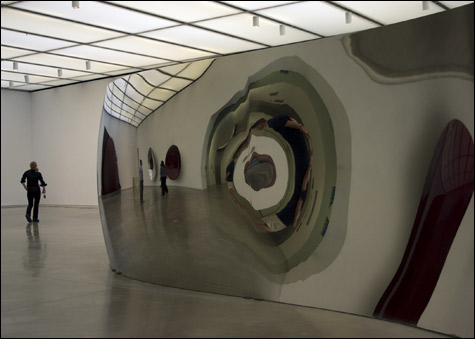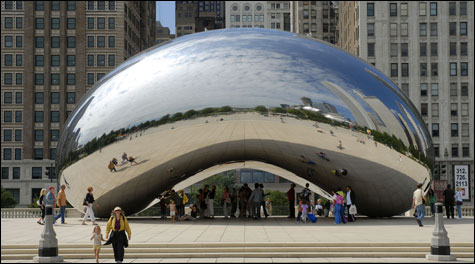
S-CURVE Kapoor evokes the sublime by deploying the sleight-of-hand and spectacle of carnival fun
houses and science-fiction special effects.
|
Over the winter, I made my third or fourth pilgrimage to Anish Kapoor’s Cloud Gate in Chicago. People there have affectionately nicknamed it the “Bean” because it resembles a giant floating bean of liquid mercury that’s drifted down into the middle of the downtown plaza from outer space. Bemused crowds stand around and stare and snap photos and giggle.The 2004 sculpture is Kapoor’s masterpiece, and one of the best public sculptures in the country. It’s a metaphorical gateway arch to the city, tall enough for crowds of people to walk under. Like the best public art, it identifies and then embodies the meaning of its location — in this case a park that showcases the city’s skyline to one side and its lake shore on the other. The sculpture’s polished steel surface mirrors and frames and swallows these vistas, and the people standing around it, like, as a friend says, a giant snow globe turned inside out. The roof inside is concave and operates like a funhouse mirror, warping the reflections of the people underneath and seeming to funnel up into some portal to another dimension.
“The modernist tradition in form is mostly phallic, mostly upward and onward, and it leads to the rocket and the spaceship,” the London artist told me at the Institute of Contemporary Art last week, where “Anish Kapoor: Past, Present, Future,” which is billed as his first major US survey in 15 years, opened on Friday. “I have a feeling that the truly modern — meaning modern of today — the ultramodern form is inside out. And I’m trying to look for it. I try to look for inside-out forms. If one could say there’s a shape to the Internet, I’d say it was inside out. Or rather, involuting.”
The 14 works here — 10 of which, according to the ICA, have never been exhibited in this country before — lay out Kapoor’s primary motifs: velvety pigment-covered geometric and architectural forms, which he focused on from the late ’70s to the mid ’80s; voids or black holes, which became a focus in the mid ’80s; magic mirrors and resin blocks with Rorschach-test bubbles trapped inside, which enter his work in the mid ’90s; and big blobs of sticky red gunk that he’s produced this decade. They’re not as astonishing as the Chicago sculpture (what could be?) but they’re quite fetching.

Cloud Gate: LOCATION/DATE Chicago 2004, PROJECT RUNNER-UP Jeff Koons, INSPIRATION l
iquid mercury, COMPOSITION stainless-steel plates, HEIGHT 33 feet, WIDTH 66 feet, HEIGHT OF
“GATE” 12 feet, WEIGHT 110 tons, COST $23 million
|
Kapoor was born in India in 1954 and grew up there. Some detect Indian accents in his work — the elemental geometric forms of an 18th-century Indian astronomical observatory, the vermilion smeared on statues in roadside shrines. But like most artists who came of age in the ’70s, he has as his first language is minimalism. He adheres to its practice of focusing on subtle relationships among simple objects, the viewer, and the space they share. Classic minimalism tends to be difficult, buttoned-up stuff predicated on the notion that if you concentrate on it hard enough and are worthy, you might discover transcendence. What sets Kapoor apart and makes him such a crowd pleaser is that he meets his audience more than halfway, deploying the sleight-of-hand and the spectacle of carnival funhouses and science-fiction special effects to evoke the sublime. This tactic has deep resonances: religions and governments have long used it to impress people, tapping our hardwired drive to invest mysterious forms — cathedral domes, the obelisk of the Washington monument — with major meaning.“Past, Present, Future” opens with a splash: S-Curve (2006), a 32-foot-long wall of steel polished to a mirror finish and bent into its namesake shape. Kapoor’s work looks like nothing in reproduction; you have to experience it in person to get it. S-Curve shifts from convex to concave along its length, squashing and stretching your reflection as you walk by. The reflected floor seems to puddle up, until it flips open and unspools.
Brandy Wine and Hexagon Mirror (both 2007) look like giant mirrored concave contact lenses stuck to the gallery wall. Brandy Wine is smooth and red; Hexagon Mirror is made up of hundreds of little hexagonal mirrors that reflect back a bug-eye view of the world. From a distance they reflect the room upside down, dark across the top half, light at bottom. But as you get close, the reflection flips and warps and magnifies. And your eyes flip out.